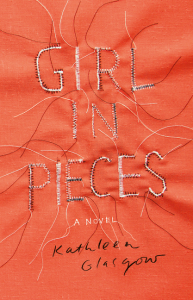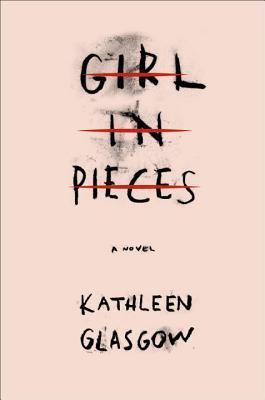By turns harrowing and heartwarming, Kathleen Glasgow’s Girl in Pieces (Delacorte Press, Aug. 2016) is a raw and intimate portrait of a young woman learning to live again.
Genre: Contemporary YA
When seventeen-year-old Charlotte wakes up in hospital following a violent suicide attempt, her life is in pieces. She has no home and no support network, just a head full of bad memories from losing her best friend and trying to survive on the streets. When her grandmother’s insurance (which is paying for her hospital stay) is abruptly cut off, well before Charlie feels ready to rejoin the wider world, she doesn’t know what to do. The only way she knows how to cope is by hurting herself, but she’s determined not to fall back into destructive habits.
When an old friend offers her his apartment in Tucson while his band’s on tour, Charlie readily accepts. She gets a job washing dishes at a local cafe, finds a room to rent and even starts to make a few friends. However, not everyone she meets has her best interests at heart and building a new life isn’t as easy as it seems.
By turns harrowing and heartwarming, Kathleen Glasgow’s Girl in Pieces (Delacorte Press, Aug. 2016) is a raw and intimate portrait of a young woman learning to live again.
HarperCollins, who publish the title here in Australia, have hailed Girl in Pieces as ‘A Girl, Interrupted for a new generation’ (although, it’s worth noting that while Glasgow discusses her experiences with mental illness in her author’s note, Girl in Pieces is fiction, while Girl, Interrupted is non-fiction). In high school, I was completely obsessed with both Kaysen’s memoir and the 1999 film adaptation, and because I’m a total sucker for ‘if you like this, try this’ comparisons, I was peachy keen to read Girl in Pieces. BUT I had a few reservations. The title sounds like that of a Degrassi High episode about self-harm, which wasn’t a great start. I received a US ARC of the book, and the cover further deepened my suspicions that Girl in Pieces would be primarily a story designed to educate its reader about capital-I Issues. Joy.

Side note: I’m a much bigger fan of the Australian cover.

I want to make a point about the cover and the title because they almost kept me from reading Girl in Pieces, and I would hate for other readers to miss out on this book for the same reason. Because, guys, this book is awesome. One of my fave YA reads this year (along with Cath Crowley’s Words in Deep Blue and Kirsty Eagar’s Summer Skin. READ THEM).
Yes, Girl in Pieces features characters who self-harm but avoids reading like an issues-based story, as Glasgow builds her narrative around Charlie’s character rather than her illness. It’s narrated in fragments of varying length: short snippets when Charlie feels overwhelmed and scattered, with longer, flowing passages when she feels more in control. I thought this enhanced Charlie’s voice and drew the reader deeper into her world. However, in the ARC I received, these ‘pieces’ were separated by ‘cuts’ similar those on the cover, which felt a) uber obvious and b) in poor taste.
Okay, I swear I’m done ranting about the design.
This book hurt my heart. In a good way. I can’t remember the last time I found myself rooting for a character so fiercely. I wanted to reach into my Kindle and give Charlie the biggest hug of her life.
I loved Charlie because she fights on every. Single. Page. One of the book’s great strengths is the way Glasgow puts the reader in Charlie’s world. The whole time I was reading, I felt the dark, sucking trauma of Charlie’s past pulling her towards self-destruction, and understood how easy it would be for her to give in and how much strength it required on her part to keep moving forward. The stakes are incredibly high; throughout much of the story, there is a very real danger that Charlie could lose control and end her life. But she refuses to yield to self-pity. Her driving desire is to get well, and even though the odds are stacked against her and the people around her aren’t always supportive, she never gives up.
I also really appreciated that the supporting cast wasn’t just there to help/antagonise Charlie. The girls she meets in hospital, her co-workers at the cafe, the tenants in her apartment building, her old friends, her boyfriend—each has their own story, and Charlie isn’t the centre of their lives, the way protagonists sometimes are in YA novels.
However, while I loved Girl in Pieces, it’s a chunky read, and for me, 400+ pages felt too long for contemporary YA, especially when much of the story is so harrowing. I was utterly exhausted by the end. Charlie is in hospital for the first quarter of the book, and while I enjoyed this section, the story doesn’t really gain momentum until she gets off the bus in Tuscon and I felt a lot of what comes before this could have been cut or included as flashbacks later on.
I also found the ending a little too convenient. It’s an unwritten rule that contemporary YA narratives end with a ‘hopefully ever after’, so I don’t think it’s a spoiler to say that Charlie survives the book. But she ends up being handed this incredible opportunity by a character who shows up at the eleventh hour, and while the opportunity kinda-sorta-if-you-squint-a-bit comes about as a result of things Charlie’s done (trying really hard not to give too much away here), it feels a bit deus ex machina. While I was happy for Charlie, I felt that the ease of the ending undermined her hard work. Colour me sceptical, but sometimes we don’t need the glamourous happy ending. Sometimes it’s enough just to be okay.
Girl in Pieces is a tough and, at times, gruelling read. Glasgow doesn’t sugarcoat the details of Charlie’s illness, nor shy away from the other characters’ destructive habits. In recent years, a lot of YA narratives have explored mental illness, and I’ve seen a lot of these narratives criticised for either glamorising or misrepresenting it. I’m not a psychologist/psychiatrist and nor have I experienced anything like what Charlie goes through, so I can hardly offer an expert opinion, but to me, Girl in Pieces felt refreshingly raw and honest, and there is absolutely nothing romantic about what Charlie goes through.
I highly recommend Girl in Pieces, with the caution that it’ll grab your heart and squeeze hard until it hurts.

See Girl in Pieces on Goodreads and purchase through Booktopia and Book Depository.
Thank you to Delacorte Press for providing a copy of Girl in Pieces in exchange for an honest review.
P.S. I feel a bit awkward and self-promote-y writing this, but for whatever reason, this review has become one of the most popular posts on Lectito. Which I’m thrilled about. Girl in Pieces is a brilliant book and I hope it continues to find new readers. So, the self-promote-y part is that my novel, Neverland, also follows a young woman dealing with mental health issues and self-harm (although her story is very different to Charlie’s). So, if you enjoyed Girl in Pieces, or like the sound of it, Neverland might be your kind of book. You can read more about it and add it on Goodreads, and purchase online via Booktopia and Book Depository.
—Margot XO
Like what you see? Keep in touch:
 |
 |
 |
 |



